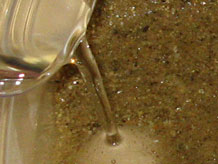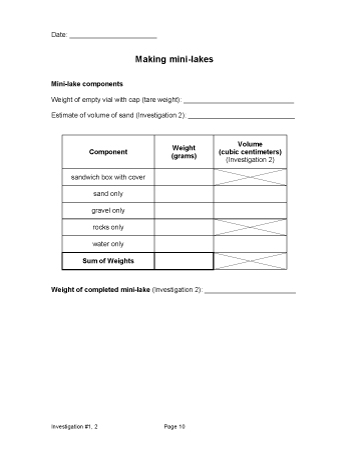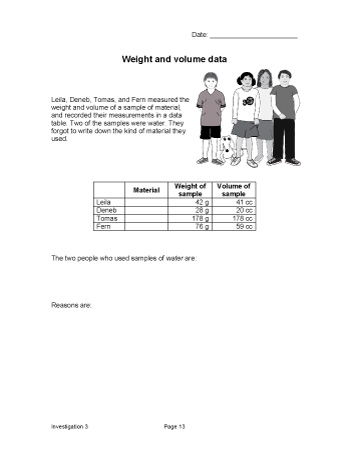How does water compare with sand?
Plan Investigation 3

In the previous investigation, students sought to explain a difference in weight between the entire mini-lake and the sum of its parts. In this investigation the issue of measurement discrepancy emerges again. The likely reason is a combination of factors: limitations of our measurement tools, and limitations of human perception.
Today, as students explore the ways in which sand and water are the same and different, they discover that a gram of sand has less volume than a gram of water. Sand is "heavy for size" in comparison with water. Students also discover that a gram of water has a volume of one cubic centimeter (and vice versa), but in the process they confront the fact that measurements do not always provide us with precisely accurate information about the quantity of matter we are investigating.
By the end of this investigation students will recognize that sand is "heavy for size" in comparison with water, that one cubic centimeter of water weighs one gram, and that the process of measurement includes taking into account possible sources of error.
Learning Goals
- Understand that one cubic centimeter of water weighs one gram and one gram of water has a volume of 1 cubic centimeter
- Understand that measurement includes taking into account possible sources of error
| Sequence of experiences | ||
|---|---|---|
| 1. Ask the question | All Class | 10 Mins |
| 2. Share the data | Small Groups | 20 Mins |
| 3. Add properties to T-chart | Discussion | 5 Mins |
| 4. Make meaning | Individual | 10 Mins |
Materials and Preparation
For the class:
- Post the investigation question in a place where all students can see it.
- Make a class T-chart titled, "Comparison of Water and Sand"; an example is found in Step 1.
- Make a class data table titled, "Weight and Volume of Water and Sand" with weight data entered and sorted in Column 2; an example is found in Step 2.
For each group:
- 1 capped vial completely filled with water
- 1 capped vial completely filled with sand
Note: If possible, have teams enter their data in Columns 1, 3, and 4 prior to the start of Investigation 3. Student data is found on the [Making mini-lakes] page in the Science Notebook.







